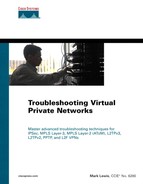Chapter 6 Review Questions & Answers
| 1: | What transport mechanism is used for neighbor discovery between directly connected LDP peers? |
| A1: | Answer: The all routers multicast address (UDP 224.0.0.2) is used. |
| 2: | What is the LIB? |
| A2: | Answer: The Label Information Base (LIB) contains all bindings. This includes all local label bindings and all label bindings received from peer LSRs (assuming liberal label retention). |
| 3: | What is the LFIB? |
| A3: | Answer: The LFIB is the Label Forwarding Information Base. The LFIB stores only those label bindings used for forwarding. |
| 4: | What is a VRF? |
| A4: | Answer: A VPN Routing and Forwarding instance. |
| 5: | How are overlapping customer address spaces disambiguated in the MPLS VPN backbone? |
| A5: | Answer: A Route Distinguisher (RD) is used to disambiguate IP address space. |
| 6: | Which BGP extended community is used to control which VPN routes are imported into VRFs? |
| A6: | Answer: The Route Target (RT) extended community. |
| 7: | Which routing protocols can be used between Cisco CE and PE routers? |
| A7: | Answer: Currently RIPv2, EIGRP, OSPF, and EBGP. Note that static routes can also be used. |
| 8: | What label distribution protocol is used to advertise VPN labels? |
| A8: | Answer: VPN labels are advertised by MP-BGP. |
| 9: | What label distribution protocol is used with MPLS traffic engineering on Cisco routers? |
| A9: | Answer: RSVP. |
| 10: | What are the default and data MDTs? |
| A10: | Answer: The default Multicast Distribution Tree (MDT) is used to distribute customer multicast traffic and control packets to all PE routers in the MVPN.
The data MDT can be used to distribute high-rate multicast traffic to only those PE routers connected to sites with receivers. |
..................Content has been hidden....................
You can't read the all page of ebook, please click here login for view all page.
